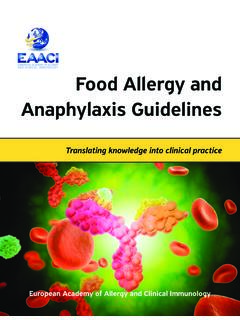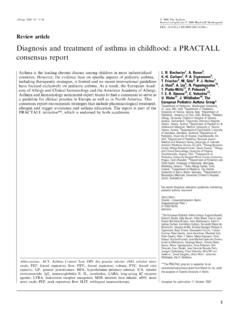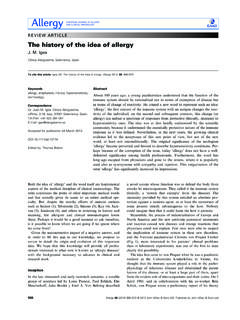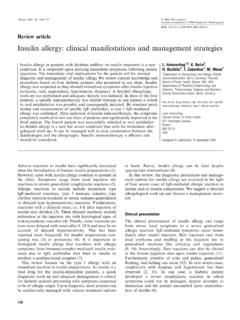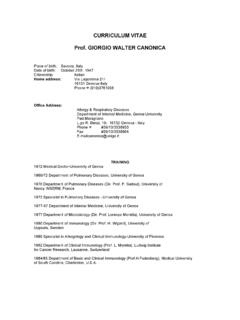Transcription of Standardizationoffoodchallengesinpatientswithimmediate ...
1 Review articleStandardization of food challenges in patients with immediatereactions to foods position paper from the European Academyof Allergology and Clinical ImmunologyAt present, the double blind placebo controlled foodchallenge (DBPCFC) represents the only way to establishor rule out an adverse reaction to a food in older childrenand adults, whereas an open challenge controlled bytrained personnel is sufficient in infants and youngchildren (1). The challenge procedure is not, however,C. Bindslev-Jensen1, B. K. Ballmer-Weber2, U. Bengtsson3, C. Blanco4,C. Ebner5, J. Hourihane6,A. C. Knulst7, D. A. Moneret-Vautrin8,K. Nekam9, B. Niggemann10,M. Osterballe1, C. Ortolani11,J. Ring12, C. Schnopp13, T. Werfel141 Allergy Center, Odense University Hospital,Odense, Denmark;2 Allergy Unit, Department ofDermatology, University Hospital Zurich, Zurich,Switzerland;3 The Asthma and Allergy ResearchGroup, Department of Respiratory, Medicine andAllergy, Sahlgrenska University Hospital,Gothenburg, Sweden;4 Secci*n de Alergia,Hospital Dr Negr,n, Las Palmas de , Spain;5 Allergieambulatorium, Wien, Austria;6 WellcomeTrust Clinical Research Facility, SouthamptonUniversity Hospitals NH STrust, Southampton, UK;7 Department of Dermatology/Allergology, UniversityMedical Center Utrecht, Utrecht, The Netherlands;8 Intern Medicine, Clinical Immunology andAllergology, Hospital Central, Nancy, France;9 Department of Allergy and Clinical Immunology,Polyclinic of the Hospitaller Brothers of St.
2 John ofGod, Budapest, Hungary;10 Department of PediatricPneumology and Immunology, University Children'sHospital Charit>, Berlin, Germany;11 Allergy/ClinicalImmunology, Niguarda Ca'Granda, Milan, Italy;12 Department of Dermatology and Allergology,Technische Universit?t M@nchen, Munich, Germany;13 Division Environmental Dermatology andAllergology GSF/TUM, Department Dermatology andAllergy Biederstein, Technische Universit?tM@nchen, Munich, Germany;14 Department ofDermatology and Allergology, Haut Klinik Linden,Hannover Medical University, Hannover, GermanyCarsten Bindslev-JensenAllergy CenterOdense University HospitalDK5000 OdenseDenmarkAccepted for publication 23 November 2003 Allergy 2004: 59: 690 697 Printed in UK. All rights reservedCopyright Blackwell Munksgaard 2004 ALLERGY690fully developed and no standardised procedure has so farbeen agreed upon, although a manual describing severalof the issues has previously been published (2). For thesafety and feasibility of the patient undergoing challengethere is a need for standardisation of the also allows for comparison of resultsbetween different centers and different populations inscientific protocols.
3 This Position Paper gives advice onhow the procedures can be performed, but since there areno direct comparative studies available in the literaturedirectly comparing the various parameters ( timingbetween two subsequent challenges or increment of thedose for challenge) we have not been able to recommendtruly evidence based guidelines. It is also important torealize, that legislative aspects vary in different countrieswithin Europe, and that the guidelines presented hereinmust be adjusted according to local legislation. Further-more this guideline does not constitute a guideline forEthics Committees to decide feasibility of DBPCFC in ascientific are several issues to be determined, prior tocommencing a challenge in a patient. These can be dividedinto patient-related parameters, which are parametersconcerning the actual patient in question and procedure-related parameters, which deal with the parametersindependent of the patient in question (Table 1).
4 Selection of patients for challengeChallenge should be performed either for establishmentor exclusion of the diagnosis, for scientific reasons inclinical trials or for enabling determination of thesensitivity of the actual patient (threshold value) or fordetermining the allergenicity of foods. The determinationof the sensitivity both enables tailor-made guidelines forthe patient and opens the possibility of following sensi-tivity by repeated challenges especially in children withfood allergies normally outgrown during childhood(cow s milk or hen s egg).Patients should be investigated according to theEAACI guidelines (1) using case history combined within vivoandin vitrotesting supplemented with a elimin-ation diet period prior to challenge when necessary. Basedon the findings here, the patient-related parameters canbe guidelines in this position paper focus mainly onpatients presenting classical immediate type allergicsymptoms and signs (IgE-mediated type I allergy), asdefined in EAACI position paper (1).
5 Inclusion criteriaPatients of any age with a history of adverse reaction to afood: For establishment or exclusion of the diagnosis of foodintolerance/allergy For scientific reasons in clinical trials For determination of the threshold value or degree ofsensitivity For assessment of tolerance. Once diagnosed, when apatient is suspected to have outgrown his clinicalallergy especially in children, whose food allergiesnormally outgrow during childhood, cow s milk orhen s egg without specific history of adverse reaction to afood: If any chronic symptom is suspected by the patient orthe physician to be food-related If a patient is on an improper elimination diet - with-out history of adverse food reaction , the food has tobe reintroduced and there are reasons for suspectingthat an adverse reaction is possible. If a sensitization to a food is diagnosed and tolerance isnot known for example, sensitization to cross-react-ive foods that have not been eaten after the patients for DBPCFC include:1.
6 All patients with suspicion of an immediate, systemicallergic reaction to a food for establishment or exclu-sion of the diagnosis2. in infants and children three years, an open chal-lenge controlled and evaluated by a physician is mostoften Patients with pollen related oral allergy syndrome (5)as their only symptom should only undergo DBPCFC outside scientific protocols in selected cases; forexample in cases with discrepancy between case historyand outcome ofin vivoand/orin open challenge may precede DBPCFC in olderchildren and adults because a negative result hereinrenders DBPCFC unnecessary. Open challenges shouldnot be applied in cases with a high probability of aTable related parameters age of the patient clinical features of the suspected reaction severity of the reaction dosing (start dose, increment, top dose) timing between challenges regimen (in-patient or out-patient) special considerations (concomitant factors)such as a possible influence of concomitantexercise (3) or intake of drugs such asb-blockers, ACE-inhibitors or aspirin (4), alcohol,antihistamines, corticosteroidsProcedure related parameters settings (trained personnel) safety measures informed consent procedures blinding procedure statistical evaluationFood allergy challenge procedures691positive outcome or in cases with subjective and/orcontroversial symptoms only (6).
7 There are, however other types of patients, who alsoshould be investigated in a standardised programme:1. patients with isolated, late reactions such as a sub-group of patients with atopic eczema dermatitis syn-drome (AEDS) (7 12). In the majority of AEDS patients with associated food hypersensitivity animmediate reaction is seen (eg exanthema, flushing,urticaria together with symptoms and signs from therespiratory and gastrointestinal tract), but data areaccumulating on a subgroup of patients who onlyexperience exacerbation of their eczema within24 48 hours after challenge. In such patients, thechallenge procedure should be adjusted to meet thedemands concerning timing and settings (11 15).2. patients with controversial symptoms often ofsubjective nature such as chronic fatigue syndrome,multiple chemical sensitivities, migraine or joint com-plaints, who are presenting symptoms which are not inaccordance with classical atopic symptoms. Suchpatients should only be investigated in strict scientificprotocols with special attention to the statistical eval-uation of the outcome, see Statistics section (6).
8 3. patients with chronic urticaria, where a subgroup isreactive to additives or to high doses of special foods( tomatoes) (16 24). Standardised protocols forDBPCFC in these patients have so far not been fullydeveloped, and the actual incidence of food depend-ent chronic urticaria remains to be patients with isolated late reactions in the gut (25, 26).Also for this group of patients, special attention mustbe paid to the lack of knowledge of incidence andnature of reaction, since these patients have not beenfinally guidelines for these four latter groups are notdealt with in this Position Paper. In these patients, thechallenge procedures must be adjusted according to thenature and severity of the reactions. Detailed guidelinesfor such patients have so far not been developed within theEAACI. A detailed position paper which has just beenpublished from the German Society of Allergology andClinical Immunology for identification of the latereactions in AD is now being modified for the EAACI(13).
9 Challenge is thus performed when the diagnosis is notmade by case history and outcome of invivo/in vitrotests,in scientific protocols for research purposes, or when apatient is suspected to have outgrown his/her criteria1. Patients with a clear cut case history of anaphylaxis (ora severe systemic reaction) to one or more specific fooditems should not be challenged, provided the risk ofmisinterpretation of a positive skin prick test orspecific IgE due to clinically insignificant cross reactionis considered and ruled out - this may be the case forinstance in patients with a false positive specific IgE topeanut due to grass pollen sensitization (27). Thepotential risk to the patient must always be weighedagainst the risk of misinterpreting skin prick testresults or positive findings in specific define Anaphylaxis according to EAACI 2002,comparable to class 3 to 4 in the Mu ller classification ofreactions to bee or wasp (28).2. In selected cases where positive test results makeschallenge unnecessary as is the case in children withpositive spt to egg and specific IgE (CAP) above acertain level from KUA/L to KUA/L, inwhich the probability of a positive challenge outcomeexceeds 95%.
10 At present, such a correlation has onlybeen demonstrated in children with AEDS and allergyto selected foods (29 32). By omitting challenge,determination of the clinical sensitivity ( threshold )ofthe patient is not possible (33).3. Patients with ongoing disease should not be patients with acute infection, unstable anginapectoris or patients with seasonal allergy during theseason. Patients with chronic atopic disease such asasthma or AEDS should only be challenged whendisease activity is at a stable and low level. Pregnantwomen should not be Patients taking medication which may enhance,mask, delay or prevent evaluation of a reaction orinterfere with treatment of a reaction should not bechallenged. Drugs include antihistamines, neurolep-tics, oral steroid above 5 mg per day, aspirin andother NSAID s, ACE-inhibitors, beta-blockers andclinical experience and new drugs may extend thelist. Medication such as short actingb2-agonists,inhaled or topical steroids can normally be continuedduring challenge, but the amount used must be keptat a fixed level.
